

La verdad entre todos: una selección de artículos de educación. “No queremos una verdad de otros a la que se nos invita, sino una verdad nuestra entre todos, hecha de fragmentos memorables que sólo existen por la convergencia con otras aportaciones tan minúsculas como indispensables“, dice Antonio Lafuente en el texto que cierra la selección de los 20 artículos que más me han gustado este año, entre todos los que he leído en este 2019.
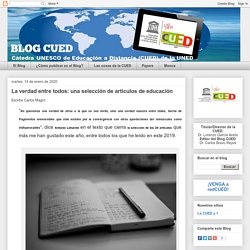
Una selección que como todas es incompleta y, en cierta manera, injusta pues deja fuera muchos otros buenos artículos que también me interesaron por lo que decían o por lo que no decían, artículos que me conectaron con otros artículos y que me llevaron seguramente hasta alguno de los que sí he seleccionado. Lo que es seguro es que los unos (los 20 de la selección) y los otros (los que no he incluido) contribuyen a construir esa “verdad” nos solo para todos, sino entre todos de la que habla Antonio Lafuente en su texto.
Una verdad que “no se hace al margen nuestro, sino que es una construcción relacional”. 1. 2. Educación: 10 tendencias que afectan a la enseñanza en todo el mundo. ¿Cuáles son las nuevas tendencias internacionales en materia de educación y cómo van a afectar a los sistemas educativos en todo el mundo?
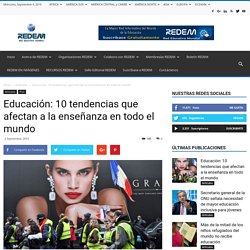
Andreas Schleicher, director de educación de la OCDE y coordinador de PISA (siglas en inglés del Programa Internacional para la Evaluación de Estudiantes), explica cuáles son las grandes interrogantes en temas sociales, económicos, políticos y tecnológicos que se plantean las escuelas de todo el mundo. 1. What's Next in Learning? Four Future Trends. Imagine a platform that enabled you to access local and national opportunities from your smartphone or computer, a place where you can pursue your interests with mentors and peers, building new skills and habits wherever you are, whenever you want.
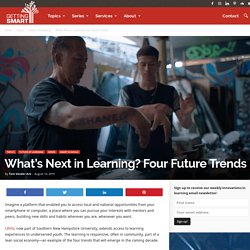
LRNG, now part of Southern New Hampshire University, extends access to learning experiences to underserved youth. The learning is responsive, often in community, part of a lean social economy—an example of the four trends that will emerge in the coming decade. These ‘next trends’ build on mega trends, emerging trends and adjacent trends in global learning. 1. Responsive. Being “nimble and agile,” as America Succeeds recommends, requires education institutions to be in ongoing conversation with key stakeholders and facilitating a set of temporary agreements about updated learning goals (the number one mega trend) and renewing a commitment to equity as demographics change (the number one adjacent trend). 2. 3. 4. For more, see: Will traditional classroom become obsolete when schools ushering in 3.0 era? On July 27th, we wrapped up the first Summer GET (Global Education Technology) Learning Festival in Shanghai under the theme of “Lifelong Learning” where Mr.
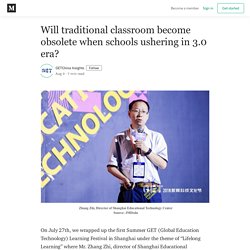
Zhang Zhi, director of Shanghai Educational Technology Center addressed a keynote on “Schools ushering in 3.0 Era”, leading the audience to reflect on how traditional schools should be reformed from the perspective of education model transformation. In this piece, JMDedu put together Director Zhang’s talk to unveil Chinese scholars’ insights regarding schools’ revolutionary shift as well as his predictions of some future trends in this field to overseas readers. Why schools have to change? Zhang Zhi believes that today’s children are all “digital natives” which is referred to “a person born or brought up during the age of digital technology and so familiar with computers and the Internet from an early age”.
AI’s impact on human society is irreversible that is expected to revolutionize humans’ lifestyle by 2050. Las 8 tendencias educativas de las aulas del futuro, según Google for Education. Cinco pasos para acabar con la desigualdad de género en la educación. Uncovering Types of Knowledge in Concept Maps. 1.
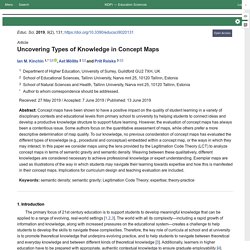
Introduction The primary focus of 21st century education is to support students to develop meaningful knowledge that can be applied to a range of evolving, real-world settings [1,2,3]. The world with all its complexity—including a rapid growth of information and knowledge, along with increased pressures on the educational system—creates a challenge to help students to develop the skills to navigate these complexities. Therefore, the key role of curricula at school and at university is to promote theoretical knowledge that underpins evolving practice, and to help students to navigate between theoretical and everyday knowledge and between different kinds of theoretical knowledge [3].
Additionally, learners in higher education have to be prepared with appropriate, authentic contextual knowledge to ensure graduate employability [4]. In this paper we explore how different types of knowledge are embedded within a concept map and interact to each other. Figure 1. 2. 3. Una técnica para aplicar de forma rápida y sencilla una innovación educativa en el aula. Irving Wladawsky-Berger: The Economic Value of Digital Identity. Identity plays a major role in our everyday life.

It’s the key that determines the particular transactions in which we can rightfully participate as well as the information we’re entitled to access. Think about going to an office, getting on a plane, logging on to a website or making an online purchase. We generally don’t pay much attention to the management of our identity credentials unless something goes seriously wrong. For much of history, our identity systems have been based on face-to-face interactions and on physical documents and processes. But, the transition to a digital economy requires radically different identity systems. A few weeks ago, the McKinsey Global Institute released Digital Identification: A key to inclusive growth, a comprehensive report at over 100 pages that examined the state of digital identities around the world. Knowledge structures for integrating working and learning: A reflection on a decade of learning technology research for workplace learning - Ley - - British Journal of Educational Technology.
Knowledge structures The term “knowledge structure” was established in the 1970s as a key concept in “cognitive science,” an emerging discipline that was established at the intersection of psychology and computer science to contribute to an understanding of the working of the mind (Schank & Abelson, 1977).
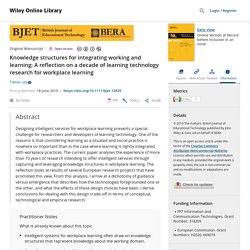
Hence, the term was conceived as boundary concept that could represent both human knowledge and those structures that would be operated by intelligent machines (AI). In education, knowledge structures were defined as the knowledge of how concepts in a domain are interrelated (Jonassen & Wang, 1993). In intelligent educational systems, these structures were utilized, for example, to adapt navigation (eg, in adaptive educational hypermedia) or to provide knowledge tracing, adaptive assessment and information presentation, or learner guidance (in intelligent tutoring systems). These theories also explain how artefacts come into existence. The guidance versus emergence continuum. Cognitions By Contexts : Learnlets. I have, in the past, talked about the three cognitions: situated, distributed, and social.
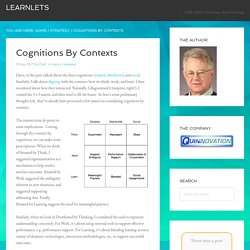
Similarly, I talk about aligning with the contexts: how we think, work, and learn. I then wondered about how they interacted. Naturally, I diagrammed it (surprise, right?). I created the 3 x 3 matrix, and then tried to fill the boxes. So here’s some preliminary thoughts (ok, they’ve already been processed a few times) on considering cognitions by contexts. The intersections do point to some implications. Similarly, when we look at Distributed by Thinking, I considered the need to represent understanding concretely. Social is a bit of a conflict, because I often mean that as a reflection of ‘work’.
Which makes me think that the whole ‘Think’ line could be Harold Jarche’s Seek > Sense > Share model, and then we’re talking about the Situated Thinking would be continually seeking new information to help settle ambiguity. Pensamiento “C”omputacional, ¿la 5ª “C” de las habilidades para el siglo XXI? Shuchi Grover, una de las voces más respetadas en relación al pensamiento computacional, escribió hace un tiempo un artículo muy interesante que hoy os traducimos y resumimos.
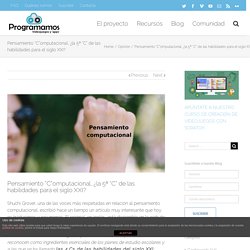
7 Education Trends to Watch in 2019. Which education trends are capturing the collective imagination this year?
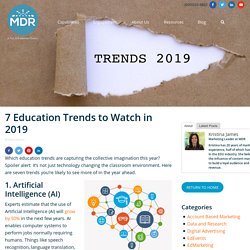
Spoiler alert: It’s not just technology changing the classroom environment. Here are seven trends you’re likely to see more of in the year ahead. 1. Artificial Intelligence (AI) Experts estimate that the use of Artificial Intelligence (AI) will grow by 50% in the next few years. 2. The magic of virtual reality is that it opens the world and removes limitations such as the constraints of the physical classroom. Mentioned in The Impact of Learning Spaces in Student Success Report, “Teachers across the country overwhelmingly agree that creative learning spaces play an important role in student engagement,” said Melissa Pelletier, MDR education research editor and an author of the study. 3. Blockchain technology is a public, permanent, shared database used to compile, connect house and encrypt digital data.
Visual design for learning. “One of the common myths in the training field is the idea some learners are ‘visual’ while others are ‘auditory.’ In reality, all learners new to a content area benefit from a relevant visual. 5 tendencias en educación vigentes para el 2019. Panorama de la educación 2017: Indicadores de la OCDE. 6449d8e2 es. La educación del futuro: conoce las tendencias más prometedoras. Tendencias y desafíos de la educación superior rumbo al 2023.